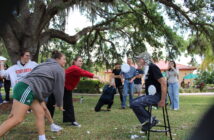By Chynna-Rose Foulkes
According to the Director of Health and Wellness Center, Terry Dadez, R.N., the common cold is an illness caused by a virus.
The common cold begins when a virus attaches to the lining of a person’s nose or throat. The immune system, the body’s defense against germs, sends out white blood cells to attack this invader. Unless students have already had a clash with that exact strain of the virus before, the initial attack fails and the body sends in reinforcements. The nose and throat get inflamed and make a lot of mucus, which accumulates in the throat, mouth, and nose.
“[College students have a cold] up to 8 times a year,” said Dadez. Students that have a common cold will have symptoms such as a scratchy or a sore throat, sneezing, stuffy nose, watery eyes, and mucus draining from the nose into the throat. More severe symptoms, such as high fever or muscle aches, may be a sign of the flu rather than a cold.
“Cold and Flu can be similar, but with the flu, you will get a high fever, nausea and vomiting, and the flu deals with more with the respiratory system,” said Laura Harvey, RN at the Health and Wellness Center.
Students can get a cold from another person who is infected with the virus. They can also contract the virus if they have touched a surface that has germs on it, such as a computer keyboard, doorknob, or silverware, and then touch their nose or mouth. They can also catch it if they’re near someone who is sick and sneezes into the air. Germs from the mouth and nose can fly into the air, where they spread and make people sick. This often happens when a person coughs, sneezes, or even blows his or her nose.
“Coughing and sneezing in their hands then touching objects that others will touch can cause the common cold to spread,” Dadez said.
Students are infected by other illness that is common on campuses. Some are “Mono, Strep, Sinus, Infections, Allergies, Bronchitis, and Ear Infection,” as stated by Dadez.
College students can also catch a common cold by staying up late and not getting sufficient sleep or not eating proper meals. Failing to take certain vitamins, such as vitamin C, can also heighten the risk of catching a bug. Exiting a cold atmosphere and then directly entering a hot atmosphere can also cause a cold.
College students are more likely to catch a common cold if they are tired, under emotional distress, have allergies, or have less vitamin C in their bloodstream. With so much of their energy directed at fighting the cold virus, they are left feeling tired and miserable.
“College students catch a cold when they first get on campus and after breaks,” said Dadez. “Students can stop germs from spreading if they always “cover their mouth and nose.”.
There are many ways to prevent spreading the common cold around campus. Students should cover their mouths and noses with their sleeves or a tissue when they sneeze or cough. Students should also remember to wash their hands with plenty soap and water. After washing their hands, students should dry their hands with a towel or hand dryer, not on their clothes.
“Our preference is to have students avoid the cold by eating right and getting sleep and exercise, but we do want to help them take care of their needs for medical care,” Dadez said. “Nurses are always free and a wealth free and a wealth of knowledge.”
For those suffering from the cold should be sure to get enough sleep to, drink plenty of warm fluids, gargle with warm salt water to soothe a sore throat, breathe the steam from hot beverages and soups or take a hot shower to help reduce the nasal congestion, and avoid smoke and other irritants.
“Do not take antibiotics to treat the cold,” said Harvey.
Some medications to take for the common cold are antihistamines, decongestants, pain relievers, cough suppressants and nasal strips.
Dadez and Harvey suggest that college students come to the doctor and get a regular check-up and, should they get sick, a prescription. Take note that prevention is better than cure.






